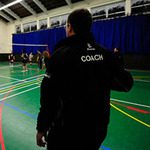A poster in a an online group asked members how much they trained infrequent elements of the game. We’re not talking about something like making a pancake dig. Rather, they were referring to events that require a bit of creativity in skill and/or execution. It’s the sort of thing that might only happen once in a tournament, or even a season.
Obviously, we’re not going to explicitly spend any real training time of things that probably won’t happen. That wouldn’t be a particularly efficient use of our time. What we can – and should – do, however, is train the kind of problem-solving mentality required in those kinds of instances.
How do we do that?
Put the players in game situations and introduce constraints that force them to do things differently than would otherwise be the case. A very simple example of this is playing 2-touch. There the players have to figure out how to create scoring opportunities off the first contact.
Here’s a more complex example.
Play a game where the first two contacts cannot be with hands (no setting). Then set the scoring such that a team gets bonus points for scoring off a 1st tempo ball (i.e. quick attack). Or perhaps the pipe/bic if that’s something that features in your team’s offense. Then let the players figure out how to do it with bump sets.
If you find they aren’t really even trying, you can go one of two ways. Increase the bonus or shift the scoring so they only thing that earns a point is the faster plays.
I should also note that if you use game-play frequently in your practices (e.g. small-sided games) the players will inherently experience a lot of different scenarios. We you see an opportunity for them to think outside the normal patterns – like attacking a 2nd ball rather than setting it – make sure to point it out, ask them questions, and otherwise get them thinking in a new direction.
6 Steps to Better Practices – Free Guide
Join my mailing list today and get this free guide to making your practices the best, along with loads more coaching tips and information.
Click Here to Read the Full Original Article at Coaching Volleyball…

